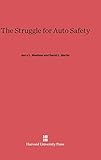The Struggle for Auto Safety / Jerry L. Mashaw, David L. Harfst.
Material type: TextPublisher: Cambridge, MA : Harvard University Press, [2013]Copyright date: ©1990Edition: Reprint 2014Description: 1 online resource (285 p.)Content type:
TextPublisher: Cambridge, MA : Harvard University Press, [2013]Copyright date: ©1990Edition: Reprint 2014Description: 1 online resource (285 p.)Content type: - 9780674423466
- 9780674423473
- Automobiles -- Safety regulations -- United States
- Automobiles -- United States -- Safety measures
- Product recall -- Law and legislation -- United States
- Recht
- Automobiles -- Safety regulations -- United States
- Automobiles -- United States -- Safety measures
- Product recall -- Law and legislation -- United States
- SOCIAL SCIENCE / General
- LAW / General
- 343.7309/44 347.303944 20
- KF2212 .M37 1990
- online - DeGruyter
| Item type | Current library | Call number | URL | Status | Notes | Barcode | |
|---|---|---|---|---|---|---|---|
 eBook
eBook
|
Biblioteca "Angelicum" Pont. Univ. S.Tommaso d'Aquino Nuvola online | online - DeGruyter (Browse shelf(Opens below)) | Online access | Not for loan (Accesso limitato) | Accesso per gli utenti autorizzati / Access for authorized users | (dgr)9780674423473 |
Frontmatter -- Contents -- Preface -- One. Regulation and Legal Culture -- Two. The Law of a Mobile Society -- Three. Science, Safety, and the Politics of Righteousness -- Four. Promise and Performance -- Five. The Great Leap Forward -- Six. The Crumbling Consensus -- Seven. Legislating Liberty -- Eight. Regulation as Recalls -- Nine. Inside NHTSA -- Ten. Regulation for an Ambivalent Polity -- Eleven. Law, Politics, and Regulatory Strategy -- Notes / Index -- Notes -- Index
restricted access online access with authorization star
http://purl.org/coar/access_right/c_16ec
Combining superb investigative reporting with incisive analysis, Jerry Mashaw and David Harfst provide a compelling account of the attempt to regulate auto safety in America. Their penetrating look inside the National Highway Traffic Safety Administration (NHTSA) spans two decades and reveals the complexities of regulating risk in a free society. Hoping to stem the tide of rising automobile deaths and injuries, Congress passed the National Traffic and Motor Vehicle Safety Act in 1966. From that point on, automakers would build cars under the watchful eyes of the federal regulators at NHTSA. Curiously, however, the agency abandoned its safety mission of setting, monitoring, and enforcing performance standards in favor of the largely symbolic act of recalling defective autos. Mashaw and Harfst argue that the regulatory shift from rules to recalls was neither a response to a new vision of the public interest nor a result of pressure by the auto industry or other interest groups. Instead, the culprit was the legal environment surrounding NHTSA and other regulatory agencies such as the EPA, OSHA, and the Consumer Product Safety Commission. The authors show how NHTSA's decisions as well as its organization, processes, and personnel were reoriented in order to comply with the demands of a legal culture that proved surprisingly resistant to regulatory pressures. This broad-gauged view of NHTSA has much to say about political idealism and personal ambition, scientific commitment and professional competition, long-range vision and political opportunism. A fascinating illustration of America's ambivalence over whether government is a source of--or solution to--social ills, The Struggle for Auto Safety offers important lessons about the design and management of effective health and safety regulatory agencies today.
Mode of access: Internet via World Wide Web.
In English.
Description based on online resource; title from PDF title page (publisher's Web site, viewed 30. Aug 2021)


